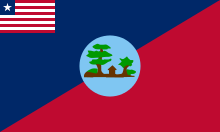Flag of Liberia
 | |
| Use | National flag and ensign |
|---|---|
| Proportion | 10:19 |
| Adopted | July 26, 1847 |
| Design | Eleven horizontal stripes alternating red and white; in the canton, a white star on a blue field |
The Liberian flag bears a close resemblance to the flag of the United States, showing the freed American and ex-Caribbean slaves offspring and bloodline origins of the country.[1]
The Liberian flag has similar red and white stripes, as well as a blue square with a white star in the canton. It was adopted on July 26, 1847.[2]
Symbolism
The eleven stripes symbolize the signatories of the Liberian Declaration of Independence, red and white symbolizing courage and moral excellence. The white star represents the first independent western-styled republic in Africa, above the blue square representing the African continent. The Liberian flag is the only flag in the world to be modeled after and resemble the American flag because Liberia was the only nation in the world that was founded, colonized, established, and controlled by freed African-American and ex-Caribbean slaves as settlers from the United States and the Caribbean islands with the help and support from the American Colonization Society, which was a private organization establishment that sent freed American and ex-Caribbean slaves as settlers from the United States and the Caribbean islands. When the freed American slaves arrived in Liberia on January 7, 1822, they identified themselves as Americo-Liberian, in which to separate themselves from the native Liberians and other settlers. The Americo-Liberian were offspring and bloodline origins of black Americans from the United States. The Americo-Liberian wasn't the only ethnic group that came to Liberia; there were other ethnic groups that came with the Americo-Liberian, which were Native American, Afro-Caribbean, African-European, and white American.[3]
The flag is seen on many ships around the world as Liberia offers registration under its flag. Shipping companies do this to avoid taxes and restrictions that other countries enforce. As the second most popular flag of convenience (after Panama), it is estimated that 1,700 foreign-owned ships fly the Liberian flag.[4] This brings in much of the country's revenue.[5]
-

Flag of the Liberian Customs Service
-

Standard of the President of Liberia
-
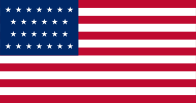
Flag of the United States (1837–1845) was used in the Commonwealth of Liberia until Saturday, April 26th 1845
County flags
Liberia is subdivided into 15 counties, each of which is entitled to its own flag. Each county flag bears the national flag of Liberia in the canton. The county flags are flown at regional offices and together encircling the national flag of Liberia at the Presidential Palace.
Similar flags
-
 United States
United States -
 Chile
Chile -
 Uruguay
Uruguay -
 Malaysia
Malaysia -
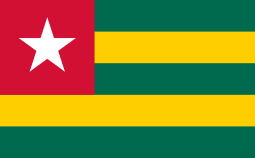 Togo
Togo -
 Goiás, Brazil
Goiás, Brazil -
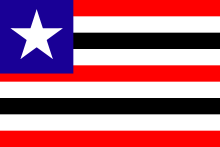 Maranhão, Brazil
Maranhão, Brazil -
 Piauí, Brazil
Piauí, Brazil -
 São Paulo State, Brazil
São Paulo State, Brazil -
 Sergipe, Brazil
Sergipe, Brazil -
.svg.png) Brittany, France
Brittany, France -
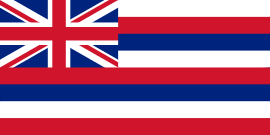 Hawaii, United States
Hawaii, United States
References
- ↑ "Background on conflict in Liberia". Archived from the original on 5 November 2007.
Paul Cuffee advocated settling freed slaves in Africa. He gained support from free black leaders in the US, and members of Congress for an early emigration plan. From 1815 to 1816, he financed and captained a successful voyage to British-ruled Sierra Leone, where he helped a small group of African-American immigrants establish themselves. Cuffee believed that African-Americans could more easily "rise to be a people" in Africa than in the US, where slavery and legislated limits on black freedom were still in place. Although Cuffee died in 1817, his early efforts to help repatriate African-Americans encouraged the American Colonization Society (ACS) to lead further settlements. The ACS was made up mostly of Friends (often called Quakers) and slaveholders, who disagreed on the issue of slavery but found common ground in support of repatriation. Friends opposed slavery but believed blacks would face better chances for freedom in Africa than in the US. The White Americans slaveholders opposed freedom for blacks but saw repatriation as a way of avoiding rebellions
- ↑ http://www.worldatlas.com/webimage/flags/countrys/africa/liberia.htm
- ↑ http://www.reliefinc.org/about-relief/directors/
- ↑ http://www.msnbc.msn.com/id/3072983/t/liberian-shipping-draws-scrutiny/
- ↑ http://www.worldflags101.com/l/liberia-flag.aspx










